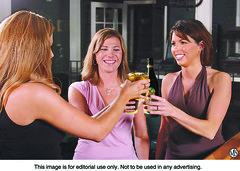All of us, no matter how skeptical we claim to be, have been impacted by Folklore at some point in our lives. From those of us who refuse to utter the words "Bloody Mary" in front of a bathroom mirror because we believe an Urban Legend, to those of us who still peer out a snow covered window on Christmas Eve in hopes of seeing eight tiny reindeer, Folklore is a part of our lives. And, what's more, Folklore seems to have had a hand in every aspect of our culture, with its clever fingers grabbing onto our customs and traditions and adding a new spin.
Not immune to Folklore is wine. Wine, having existed throughout the travels of time, comes with its own legends and its own stories. Whether or not the tales are true, we will probably never know. But, chances are, they are based on some truth. And, chances are even greater, the stories will become more believable with each glass of wine consume.
So, pour yourself a drink and enjoy some wine lore. It's Folklore that's had a few.
Women Invented Wine
The male species is credited with the invention of both the wheel and fire. Thus, it seems only fair that, in lore, women would be credited for a great invention, the invention of wine.
As Persian legend goes, wine was invented when a woman, plagued by a headache, drank fermented juice from a jar used for grape storage. After consumption, she became relaxed and at ease, eventually falling asleep and waking up cured.
However, it is believed in Greek Mythology that wine was invented by Dionysus, appropriately named the God of Wine, Intoxication, and Fertility (the coupling of Intoxication and Fertility can probably explain the Greek's booming population). As was commonly accepted, he invented wine on Mount Nyssa and soon began to cultivate grapes around the world.
While the Persians and Greeks disagree on who invented wine, chances are they both breathe a sigh of relief at the fact that at least it was invented by someone.
Abreast of Invention: The Wine Glass
Typically, we probably don't concern ourselves with the history of the wine glass, being more focused on what's inside. But, according to legend, the invention of the wine glass was a bit more unique than the typical run-of-the-mill appearance at the US Patent Office.
Dating back to Greek Mythology, it is rumored that the first wine glass was molded from the breast of Helen of Troy. Because the Greeks believed that there was something very sensual in the essence of wine, they wanted the glass that held it molded from the breast of their culture's most beautiful woman.
However, in what may have been one of history's first cat fights, Marie Antoinette, centuries later, decided she would create a new glass, molded from her own breasts. But, because Marie Antoinette was better endowed than Helen of Troy, the wine glass went from the equivalent of an A-cup to a D-cup, changing the shape of the glass entirely and, ultimately, changing how much wine a glass would hold.
Red Bearded Emperor
We all know that red wine can stain. But, what we might not know is that its ability to stain ultimately led to the offspring of white wine in Burgundy. According to Burgundy legend, an Emperor by the name of Charlemagne was an avid red wine drinker for the majority of his life. However, the more red wine he drank the more red wine would fall into his beard, leaving his naturally white beard, well, burgundy. He felt that the look wasn't one an Emperor should possess and so he began to switch to white wine, demanding a portion of the vineyards of Corton Hill be replanted with white grapes. This, ultimately, is how Corton-Charlemagne found its way into the world of wine.
German Superstitions
Germany, a nation known for fine wines, also possesses fine wine superstitions, believing certain things can cause havoc on their vineyards and wineries. In a town called Varnhalt, located near the historical state of Baden in southwest Germany, a tradition that has been carried down by generations of wine makers perpetuates the belief that the last grape harvest of the growing season must be brought home in a cart pulled by an ox. If it is brought home in any other manner, the grape harvest will be filled with sour grapes, producing undrinkable wine.
In addition, the Germans also believe that when someone dies, the wine in the cellar must be shaken nearly immediately. If it's not shaken, the wine stored will all turn sour.
When in Rome, Don't Spill Wine
Everyone has always lived by the notion that there's no use crying over spilled milk. Spilled wine, on the other hand, is another story. The Romans possessed a belief that spilling wine inadvertently was an omen of disaster, as ominous as crossing paths with a black cat or having a snake fall from the roof into a yard. When wine fell to the ground or on a table, bad things - a storm, a plague, a betrayal by Brutus - were bound to be imminent.
In fact, this is a belief that many people generally possess. Perhaps it's because there is some validity to it or perhaps it's because spilling wine is wasting wine, and therefore bad luck in itself.
However, spilling wine, when done on purpose, is believed to bring luck. The breaking of a wine filled glass is typically thought of as a good omen when performed at marriages. A token for a happy life, this act will lead to unyielding love and affection.
Wine lore is undoubtedly a part of our culture. Because wine is essential to history, it's only natural that legends, stories, and superstitions come with it, packaged in the bottle of every vintage. Because wine is so magical, having its lore in our lives has the potential to replace other types of Folklore: who needs a Bloody Mary when you can have a glass of wine?
__________________________________________________
***FUN SITE***

Wine Gifts Under $60 (Click Here!)
Send an impressive gift of Gourmet & Wine classics for under $60!
_________________________________________________
Jennifer Jordan is the senior editor at http://www.savoreachglass.com. With a vast knowledge of wine etiquette, she writes articles on everything from how to hold a glass of wine to how to hold your hair back after too many glasses. Ultimately, she writes her articles with the intention that readers will remember wine is fun and each glass of anything fun should always be savored.
Source: http://EzineArticles.com/?expert=Jennifer_Jordan http://barworks.blogspot.com










